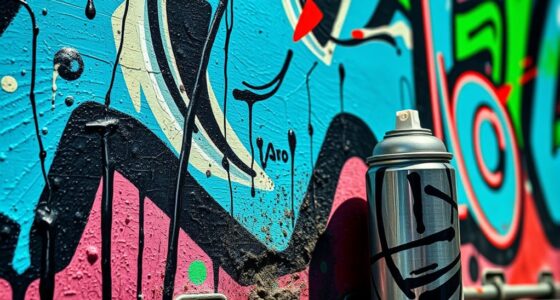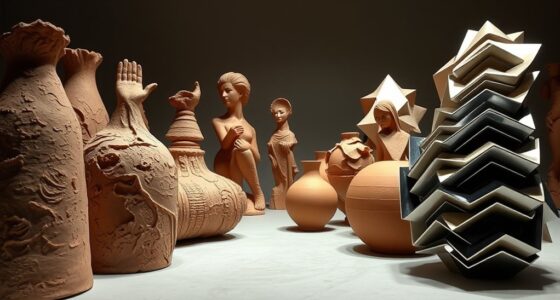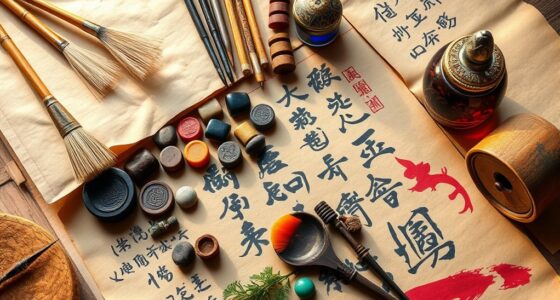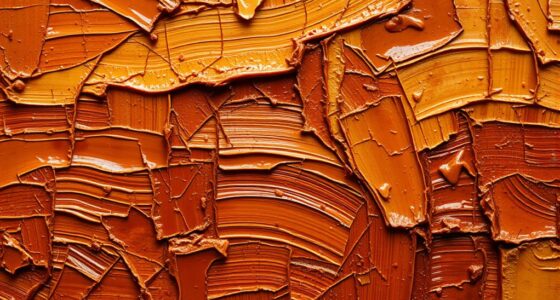Raku firing is a unique ceramic technique that uses rapid heating and quick cooling to create unpredictable glaze effects and crackled surfaces. You carefully heat your pieces to high temperatures, then cool them suddenly by placing them into combustible materials like sawdust. This process causes controlled cracking and vibrant color reactions, making each piece one-of-a-kind. Mastering temperature control and timing is essential to achieve stunning results; keep exploring to uncover the full potential of this fascinating technique.
Key Takeaways
- Raku firing involves rapid heating and cooling to create distinctive crackle and glaze effects.
- Controlled temperature shifts influence glaze reactions, textures, and vibrant color development.
- Sudden cooling by placing hot ceramics into combustible materials enhances crackle patterns.
- Precise management of firing and cooling timing is essential for unique artistic outcomes.
- Mastery of thermal control allows artists to produce unpredictable, one-of-a-kind ceramic pieces.

Have you ever wondered how artists achieve the unique, crackled finish on their pottery? The secret often lies in raku firing, a technique that produces distinctive glazing effects through rapid cooling and unpredictable results. When you engage in raku, you’re not just firing ceramics—you’re creating art with an element of surprise. The process begins with carefully applying glazes designed to crack and react under the intense heat and sudden temperature changes. These glazes often contain materials that develop unique textures and colors as they cool. But the key to achieving those captivating effects isn’t just about the glaze itself; it’s also about mastering temperature control.
During raku firing, you heat your piece quickly to a high temperature, typically around 1,650°F to 1,800°F (900°C to 980°C). This rapid heating ensures that the glaze reaches the right melting point, allowing it to develop its crackled surface. However, the real magic happens during the cooling phase. Once the piece is removed from the kiln, it’s subjected to rapid cooling—often by placing it into combustible materials like sawdust or shredded paper. This sudden temperature drop causes the glaze to contract unevenly, creating those characteristic crackles and crackled glaze effects. You need to control the timing and environment carefully; too slow, and the crackling might not develop properly, too fast, and you risk damaging the piece.
Rapid heating and cooling during raku create unique crackle effects through controlled temperature shifts.
Temperature control isn’t just about reaching the right heat; it’s about managing the entire firing and cooling process. Precise control allows you to influence the final appearance of your pottery—whether you want vibrant colors, subtle crackles, or textured surfaces. As you fire, you pay close attention to how quickly the temperature rises and falls, adjusting your techniques to influence the glaze’s reaction. Knowing when to remove the piece from the kiln and how to handle it during cooling can make all the difference in the final glazing effects. Additionally, understanding ceramic material properties can help you better predict how different clay bodies will respond to raku firing.
In essence, raku firing is a dance between heat and timing. Your skill in controlling temperature and understanding how your glazes react under these conditions will determine whether your piece showcases a delicate crackle or a bold, textured surface. It’s this interplay of rapid heating, sudden cooling, and precise timing that allows you to create truly one-of-a-kind ceramic art. So, every time you venture into raku, remember: mastering temperature control is your most powerful tool for revealing stunning glazing effects.
Frequently Asked Questions
What Safety Precautions Are Necessary for Raku Firing?
When raku firing, you need to prioritize fire safety by working in a well-ventilated area and keeping a fire extinguisher nearby. Always wear protective gear like gloves, goggles, and a respirator to shield yourself from heat and fumes. Handle hot pottery with tongs, and be cautious around the kiln. These precautions help prevent burns, inhalation hazards, and accidents, ensuring a safe and enjoyable raku firing experience.
Can Raku Firing Be Done Indoors Safely?
You can safely do raku firing indoors if you treat it like a delicate dance. Guarantee proper indoor ventilation to whisk away fumes and keep the air fresh. Use fireproof surfaces to protect your space from any sparks or heat. By controlling these elements, you transform your studio into a safe haven, letting you enjoy the fiery art of raku without risking your home or health.
How Does Raku Firing Affect Ceramic Durability?
Raku firing can reduce ceramic strength because the rapid firing process creates thermal shock and surface cracks, weakening the piece. The intense heat and quick cooling cause stress, making it more fragile over time. If you want durable ceramics, consider the firing process carefully; raku’s unique method prioritizes aesthetic effects over long-term strength. Be aware that raku pieces are more prone to chipping or breaking due to decreased durability.
What Types of Clay Are Best Suited for Raku?
You should choose clay with low porosity and minimal shrinkage for raku. Porous clay absorbs rapid temperature changes, making it ideal for quick cooling in raku firing. Clays like commercial raku clay or grog-heavy clay are excellent choices because they tolerate the thermal shock and reduce cracking. Avoid highly plastic or high-shrinkage clays, as they’re more prone to damage during the rapid heating and cooling processes.
How Does Temperature Variation Influence Raku Glaze Effects?
Temperature variation during raku firing causes glaze crackling and enhances color differentiation. As you heat and cool quickly, the glaze contracts unevenly, creating crackles that add texture. Rapid cooling also intensifies color contrasts, making your pieces visually striking. You should carefully control your kiln’s temperature fluctuations to achieve desired effects, ensuring the crackling and color differentiation complement your artistic vision for each raku piece.
Conclusion
You’ve explored the art of raku firing, discovered its unpredictable beauty, and appreciated its fleeting moments. You’ve seen how the crackles, the smoke, and the flames create unique, spontaneous masterpieces. You’ve embraced the process, the tradition, and the innovation. Now, you understand that raku isn’t just about firing pottery; it’s about capturing imperfection, celebrating individuality, and inspiring creativity. So, keep experimenting, keep creating, and let your passion for raku continue to ignite your artistic journey.









